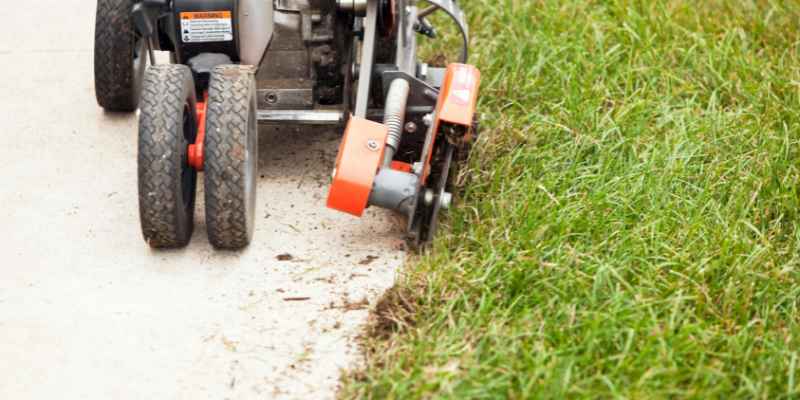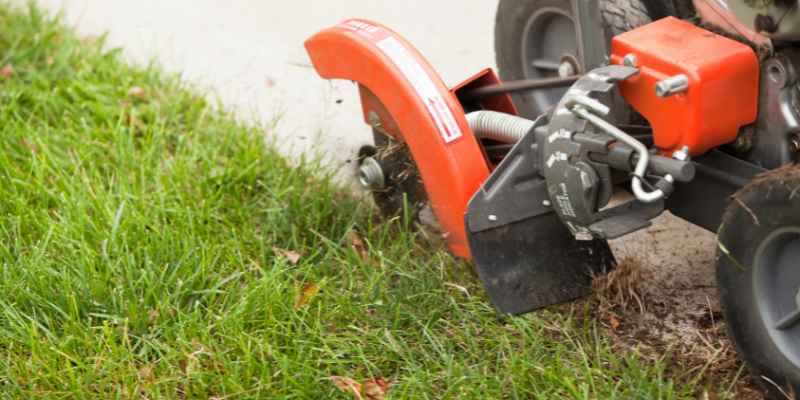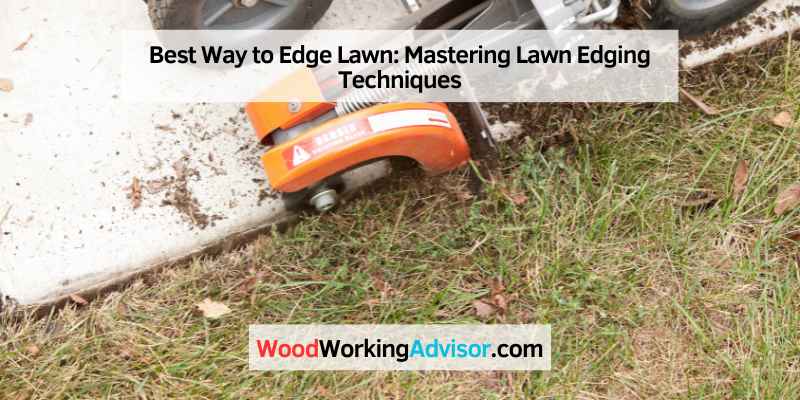The best way to edge a lawn is by using a manual edger or a string trimmer for a clean and defined edge. Creating a crisp edge for your lawn not only enhances its appearance but also makes it easier to maintain.
There are various methods to achieve a well-defined edge, but the most effective options are using a manual edger or a string trimmer. These tools allow you to cut a neat line along the edge of your lawn, separating it from surrounding walkways, flower beds, or other areas.
By following these methods, your lawn will have a professional and polished look that will make your entire yard look more groomed and maintained. We will cover the steps and tips to help you edge your lawn successfully.
Importance Of Lawn Edging
Lawn edging is a crucial aspect of maintaining a well-manicured yard. It serves multiple purposes that contribute to the overall health and aesthetics of your lawn.
Enhancing Curb Appeal
Proper lawn edging plays a significant role in enhancing the appearance of your property, creating a clean and organized look that instantly boosts your home’s curb appeal.
Defining Garden Beds
By edging your lawn, you can clearly define garden beds, preventing grass from encroaching on flower beds or vegetable patches, creating a neat separation between the lawn and other landscaping features.

Choosing The Right Tools
The best way to edge your lawn is by carefully choosing the right tools for the job. With the right equipment, you can achieve a clean and precise edge that enhances the overall appearance of your lawn.
Choosing the right tools is essential when it comes to edging your lawn effectively. The right tools can make the task much easier and ensure you achieve clean, precise edges that enhance the overall appearance of your lawn. Manual and mechanical edging tools are the two main options available. Let’s explore each of these options in detail.
Manual Edging Tools
Manual edging tools are ideal for those who prefer a hands-on approach to lawn care. These tools require physical effort but offer more control over the cutting process. Here are some popular manual edging tools to consider:
1. Spade: A traditional option that involves using a sharp spade to cut through the turf along the edges of your lawn. This method is labor-intensive but allows you to create straight or curved edges to your liking.
2. Half-Moon Edger: This tool features a half-moon-shaped steel blade on a long handle, allowing you to slice through grass and soil with ease. It offers precise cutting and is suitable for creating clean, defined edges along paths, sidewalks, or flower beds.
3. Manual Lawn Edger: Designed specifically for lawn edging, this tool comes with a sharp, flat blade and a long handle. It allows you to cut neat lines along the borders of your lawn effortlessly.
When using manual edging tools, it’s important to use proper body mechanics and take breaks to avoid strain or fatigue.
Mechanical Edging Tools
If you prefer a more efficient and less physically demanding method, mechanical edging tools are worth considering. These tools typically utilize power or machinery to get the job done. Here are a few mechanical edging tools to explore:
1. Lawn Edger: Powered by electricity or gas, a lawn edger is a convenient option that cuts through grass and soil with a spinning blade. It provides quick and precise results, allowing you to achieve professional-looking edges effortlessly.
2. Trimmer/Edger Combination: Some string trimmers come with an edging mode that allows you to switch between trimming and edging functions. This versatility makes it a popular choice for homeowners who want to tackle multiple lawn maintenance tasks with a single tool.
3. Rotary Blade Edger: This mechanical tool features a rotary blade that can create clean, straight edges along pathways, driveways, or garden beds. It is easy to operate and produces consistent results without much effort.
Before using any mechanical edging tool, familiarize yourself with its features, safety precautions, and maintenance requirements.
Preparation For Edging
Preparation for Edging is an essential step in achieving a well-defined and tidy lawn. Before you delve into the actual edging process, it’s crucial to prepare the area to ensure a smooth and efficient operation. This involves marking the edge line and clearing debris, which are vital steps for a successful and polished finish. Let’s explore these important preparatory tasks in detail:
Marking The Edge Line
Marking the edge line is the first step in preparing your lawn for edging. This involves defining the boundary where the grass meets the walkway, driveway, or garden bed. Use a string, chalk, or a specialized lawn marking spray to outline the edge. Ensure the line is consistent and aligned with the desired shape to achieve a professional-looking result.
Clearing Debris
Clearing debris from the edges of the lawn is essential before edging. Remove rocks, branches, or any other obstructions that may hinder the edging process. Additionally, ensure that the soil at the edge is clear of any roots or other impediments. This will allow the edger to move smoothly and create a clean edge without obstructions.
Mastering Edging Techniques
Mastering edging techniques is essential for achieving a beautifully manicured lawn. Whether you prefer a sharp, straight edge or a more organic curved border, mastering the art of edging can elevate the overall appearance of your outdoor space. Lets dive into the two primary techniques: Straight Edge and Curved Edge, to help you achieve professional-looking results.
Straight Edge Technique
Creating a crisp, straight edge along your lawn requires precision and attention to detail. Follow these steps for mastering the straight edge technique:
- Use a string line or garden hose to mark the path for the edge.
- Carefully use a half-moon edging tool or a power edger to cut along the marked line, ensuring a smooth and even edge.
- Once the initial edge is established, use a spade to tidy up any uneven spots and create a precise, straight line.
Curved Edge Technique
For a more natural and flowing border, the curved edge technique adds a soft and graceful touch to your lawn. Here’s how to master this technique:
- Begin by outlining the desired curve using a garden hose or spray paint.
- Using a half-moon edging tool or a manual lawn edger, carefully follow the outline of the curve, maintaining a gentle and flowing motion.
- After the initial edge is established, refine the curve with precise cuts using a spade, ensuring a graceful and uniform appearance.
Maintaining Edges
Maintaining well-defined lawn edges is crucial for a tidy and polished appearance of your outdoor space. Regular inspection and re-edging when necessary are vital steps to ensure your lawn edges remain sharp and attractive.
Regular Inspection
Regularly inspecting your lawn edges is essential for keeping them in top condition. Walk around the perimeter of your lawn and identify any areas where the grass may be encroaching onto the edges or where the edge line has become uneven or damaged.
Re-edging When Necessary
If you notice that the edges have become overgrown, uneven, or damaged, it’s time to re-edge. Use a half-moon edging tool or a manual or powered edger to redefine the edges and create a clean separation between the lawn and surrounding areas. This should be done as needed, typically a few times a year.

Dealing With Challenging Edging Situations
For optimal lawn care, handling challenging edging situations is crucial. From edging near trees to edging along pathways, each scenario requires specific techniques.
Edging Near Trees
- Use a half-moon edger tool to create clean lines around trees.
- Start by removing any grass or weeds encroaching on the tree base.
- Take care not to damage the tree roots while edging.
Edging Along Pathways
- Define the edge of the pathway using a straight edge tool.
- Ensure the edging line follows the pathway’s curves accurately.
- Trim any overgrown grass along the pathway to maintain a tidy look.
Advanced Edging Tips
Using Landscape Edging Materials
Select the right type of edging that complements your landscape design.
Materials: Metal, plastic, or stone edging provide durability and aesthetic appeal.
Creating Intricate Patterns
Intricate patterns add visual interest and define the boundaries of your lawn.
- Use a sharp spade or edging tool to carve out intricate designs.
- Consider geometric shapes or curved lines for a unique look.
- Maintain regular upkeep to preserve the sharpness of the patterns.
Finishing Touches
Once you have completed the hard work of edging your lawn, it’s time to add those finishing touches that will transform your yard into a picture-perfect paradise. These final steps not only enhance the overall appearance of your lawn but also help to maintain the edging for longer periods. Let’s dive into the best ways to put the finishing touches on your newly edged lawn.
Cleaning Edging Tools
Before considering any other steps, it is essential to clean your edging tools thoroughly. Traces of dirt, grass clippings, and excess soil can accumulate on your tools during the edging process, leading to their deterioration over time. To prevent this, wipe down your edging tools with a damp cloth or sponge and dry them off completely to ensure they remain in top-notch condition. This simple maintenance routine not only prolongs their lifespan but also helps to keep your lawn edges crisp and sharp.
Applying Mulch Or Gravel
One of the easiest and most effective ways to add the finishing touch to your lawn edges is by applying a layer of mulch or gravel. Not only does this instantly enhance the overall appearance of your yard, but it also helps to prevent weed growth and retain moisture in the soil. When applying mulch or gravel, ensure that you spread it evenly along the edges, creating a neat and uniform border. This will not only bring attention to your meticulously edged lawn but also provide a functional barrier between your grass and any surrounding flower beds or pathways.
If you’re unsure which option to choose, consider the overall aesthetic of your lawn. Mulch adds a natural and organic feel, blending seamlessly with greenery and vibrant flowers. On the other hand, gravel adds a modern and contemporary look, creating a sleek contrast against the green grass. Whichever you choose, both options provide a visually pleasing and low-maintenance solution to complete your lawn edging project.
Remember, maintaining the cleanliness and applying mulch or gravel are vital finishing touches to your freshly edged lawn. These simple steps not only enhance the visual appeal of your yard but also help to prolong the lifespan of your edging and keep it looking sharp for longer. By following these best practices, you’ll be able to enjoy a well-defined and neat lawn that will be the envy of your neighbors.
Frequently Asked Questions On Best Way To Edge Lawn
How Often Should I Edge My Lawn?
Edging your lawn every 2-3 weeks keeps it looking neat and well-maintained. Regular edging prevents grass from overgrowing onto the sidewalks or garden beds, enhancing the overall aesthetics of your lawn.
What Tools Do I Need To Edge My Lawn?
A sturdy spade or half-moon edger is essential for clean and precise edging. Additionally, a pair of gloves and safety glasses will protect you during the process. These tools ensure a professional and polished finish to your lawn.
Is It Necessary To Edge A Newly Laid Lawn?
Edging a newly laid lawn is crucial for creating clean lines and defining the boundaries. This helps in establishing a uniform and manicured look for your lawn, enhancing its overall appeal. Proper edging promotes healthy growth and maintenance of the new grass.
Conclusion
To conclude, maintaining a well-edged lawn is crucial for a visually appealing and manicured garden. Implementing the best techniques for edging can transform the overall look of your outdoor space. From using the right tools and materials to following proper steps, you have the power to create clean, defined edges that enhance the beauty of your lawn.
With a little effort and consistency, you can achieve a professional-level finish that will make your neighbors green with envy. So why wait? Start edging your lawn today and showcase a picture-perfect garden that will stand out in any neighborhood.


